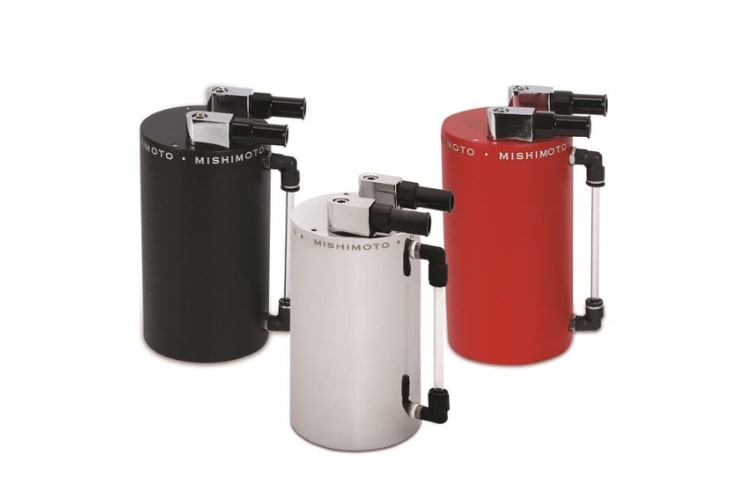Oil Catch Cans: The Complete Guide
It’s hard to imagine that, with all the talk about oil catch cans, that no car comes from the factory with one already installed. If you look under the hood of a car and see an oil catch can, it’s an after-purchase addition, designed to increase the engine’s efficiency by reducing blowby that is otherwise sent back into the engine’s intake.
What is an oil catch can?
An oil catch can captures the excess oil that passes through the piston seals into the crankcase of your car. Ideally, the oil that lubricates the pistons — necessary for the engine function — is at a precise measure with no waste. But very often the process creates the oily blowby. The oil catch can stops that blowby from going back into the air intake of the engine.

How does it work?
The oil catch can is placed between the pcv valve and the crankcase. The excess oil collects in the catch can, which must be periodically emptied and rinsed. Although there are some commercial oil catch cans available, some people create homemade models from old food jars or steel wool.
What are the benefits?
Preventing the blowby from entering the air intake keeps the engine in better condition. Ideally, the engine should use fresh air to start and run. If the blowby cycles through, that air is no longer fresh.
The result is a buildup of deposits that reduce engine efficiency. Among those deposits are carbon, which must be removed. Carbon deposits reduce the efficiency of your engine, causing disruptive shaking during idling and unexpected ignition failures. They also shorten the life of components so you may have to do maintenance more often.
What types of vehicles benefit from their use?
No engine works to optimal efficiency with blowby cycling through, and all engines will suffer irreperable damage over time. That would lead to the conclusion that all engines could potentially benefit from an oil catch can. However, drivers of high-performance vehicles potentially have the most to benefit from the installation of an oil catch can. This is because, for these cars, optimal performance at all times is essential.
Also, because of the greater potential for deposit buildup than in older engines, cars with newer gasoline direct injection (GDI) or direct fuel injection (DFI) engines especially benefit from oil catch can technology.
Is it necessary?
Strictly speaking, any car can continue to run without an oil catch can. However, if you do not install one, you have to take other steps to deal with the effects of blowby in your vehicle. One is the removal of the manifold in the DFI engine so the deposits can be cleaned off. This is a big job, but there are commercial products such as the 104+ Fuel Injector Pro to help you do it.
How else can I take care of excess oil?
There are other preventive measures you can take to extend the life of your car. In addition to blowby, your engine can also leak oil. You can spot oil leaks a number of ways, like your dipstick level dropping, blue smoke from the tailpipe, or a burning oil smell. A leak could have a number of causes, one of which is a deficiency in the oil seals. A product like No Leak actually works inside your car to condition the internal seals. That way, they are less likely to leak.
No matter how you take care of your vehicle, you have options to keep it running efficiently. Check out Gold Eagle‘s car maintenance products to get you started today.







Very true!!